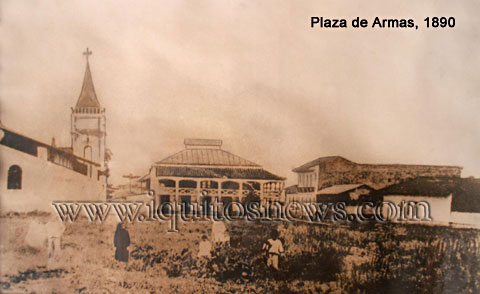
A Brief History of IquitosBy John Lane |
|
|
|
|
 |
|
he history of Iquitos really begins with the discovery of the Amazon River basin. The expedition that discovered the Amazon was instigated by “Conquistador” Francisco Pizarro, the first Governor of colonial Peru, to explore the fabled region then referred to as “El Dorado” (and which became the Department of Loreto in 1866), set out under the command of his brother Gonzalo Pizarro in 1539. Following the navigable portion of the River Napo the Spanish explorers encountered many hardships, suffering hunger and sickness, prompting Gonzalo Pizarro to send a small party ahead in search of food and support. This group led by Francisco de Orellana and assisted by friendly natives came to the River Amazon on 12th February 1542, the spot being marked today by the town of that name at the junction of the two rivers, the Napo and the Amazon. Francisco de Orellana subsequently continued all the way to the Atlantic Ocean and then returned to Spain informing the world of the discovery of the mighty Amazon River.
Three hundred and nine years later, on 23rd October 1851, the Peruvian Brazilian Agreement was signed (Peru having achieved independence from Spain in 1829) determining the free navigation of the Great Amazon River to the sea (the Friendly Trade and Navigation treaty). This declaration in turn prompted President Ramon Castilla to create the “Military Political Department of Loreto” on 7th January 1861 and to order “the construction of four steamships, a dockyard and a navy factorage from England to be installed at some point of the Amazon River.” The exact “point” on the Amazon was at that moment uncertain, with Tamshiyacu, Nauta and Francisco de Orellana all being considered. However, the strategic position of Iquitos was deemed to be superior and on 5th January 1864 the steamships of the Peruvian Navy duly started to arrive at Iquitos Village, first the “Morona” and “Pastaza” of 500 and 300 tons, and then two smaller steam boats of 50 tons, the “Napo” and the “Putumayo,” as recorded in the Museum mural by Cesar Calvo de Araujo, to be followed soon afterwards by the floating dock and the machinery for the factory.
However, between the salient dates of 1542 and 1864, proselytizing Jesuit and Franciscan missionaries were active in forming the Iquitos natives into groups or “Reducciones”. The “Reduccion” named Santa Barbara de Iquitos was on the bank of the Nanay River, formerly inhabited by the Napeanos but later named Iquitos Village due to the preponderance of Iquitos natives. The date given for the founding of this Jesuit settlement is 1757, with the first population census recording 81 people in 1808, rising to 200 in 1840. Since that time the pace of expansion accelerated, so that on 9th November 1897 Iquitos became the capital of the Department of Loreto, during the Presidency of Nicolas de Pierola, as a result of the exceptional commercial development and the population explosion flowing from the rubber boom.
The phenomenon of the rubber boom, generally accepted to have been at its height between 1880 and 1912 (hardly more than thirty years) and its effect on Iquitos merits separate attention. In 1870 the population of Iquitos was perhaps 1,500. Meanwhile, in Europe in the decade of the 1870’s, ever increasing industrialization and advancing technology, namely the invention of the process of vulcanization by Mr. Goodyear, created an unprecedented demand for latex, obtainable from the rubber trees of the rain forest. As ever, entrepreneurs were quick to move and by the 1880’s Iquitos had over 20,000 inhabitants, foremost amongst whom were the legendary “Rubber Barons,” aptly named on account of their fantastic wealth which led to all manner of extravagances and excesses, even including for a brief period of two years the printing of their own private currency, a few examples of the notes surviving to this day. The downside to these three decades of opulence and the legacy of fine houses constructed almost exclusively of materials shipped in from Europe was the exploitation of the forest Indians who as a result of their local knowledge and skills became both the locators of the “Jebe” rubber trees and the tappers, practically in conditions of slavery. The bubble burst with sudden finality when the next generation of global entrepreneurs created orderly rubber plantations in the British colony of Malaya (now part of Malaysia), thus producing plentiful latex more economically and more competitively than the ad hoc arrangements prevailing in the Amazon Rainforest. In 1902 a kilo of “Caucho” fetched S/. 2.00; by 1911 the price had risen to S/. 6.00; in 1932 the market price of a kilo had collapsed to S/. 0.45. The majority of the “Barons” sold out and abandoned Iquitos as quickly as they had arrived. The opulence of that period, which was for some a “golden era” is unlikely ever to be repeated, although revenue from oil, other mineral deposits and tourism undoubtedly have the potential to bring economic prosperity to the region and its people. In turn, that prosperity will provide the necessary resources to safe guard the rich natural and historic inheritance of Loreto.
The rubber boom has left an indelible mark on the City of Iquitos. In 1961 the City Hall of Maynas formed a commission to resolve the question of the date of the founding of Iquitos. The year was finally agreed as being 1864 and President Fernando Belaunde promulgated Law No.14702 in 1963 declaring the official date for the founding of Iquitos as the First Fluvial Port to be 5th January 1864. This date is now celebrated annually as the Iquitos "Aniversario" (anniversary).
A Brief History of Iquitos reprinted with permission from the book, Iquitos, Gateway to the Amazonía by John Lane, available at the Bookshop Tamara on the second block of Prospero.
|
